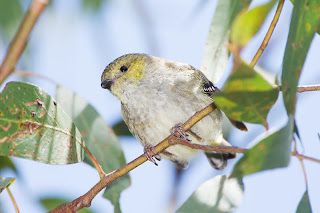 |
| Pardalotus quadragintus |
the most endangered bird species in Australia.
You will find them only in a handful of colonies on Tasmania. They used to be found on the mainland as well, but all of those birds have now died off. Habitat loss is the biggest threat to the Forty-spotted Pardalotes, because they rely on very specific conditions to live. You will only find them in dry Eucalyptus forests where there is an abundance of White Gum trees. The birds forage for insects near those specific trees, often in small groups.
Forty-spotted Pardalotes are named for the bright white dots on their wings. Males and females look alike, sporting paler undersides and darker yellow-green heads.
IUCN Status : Endangered
Location : Australia
Size : Body length 4in (10cm)
Classification : Phylum : Chordata -- Class : Aves -- Order : Passeriformes
Family : Pardalotidae -- Genus : Pardalotus -- Species : P. quadragintus
Image : JJ Harrison
Family : Pardalotidae -- Genus : Pardalotus -- Species : P. quadragintus
Comments
Post a Comment